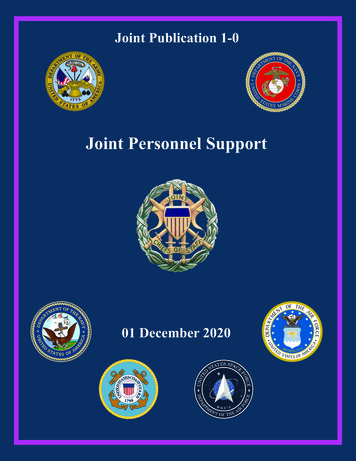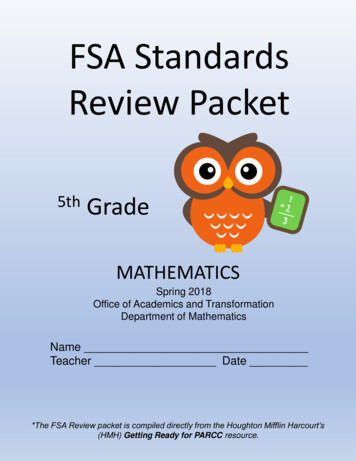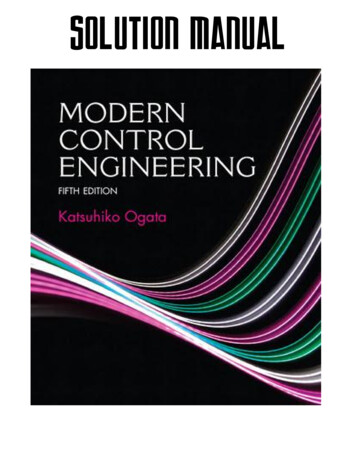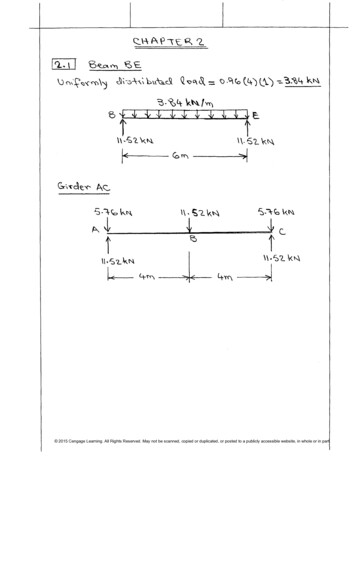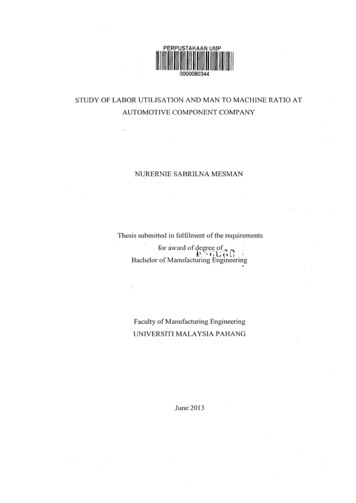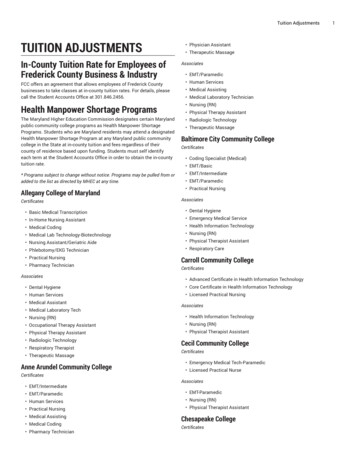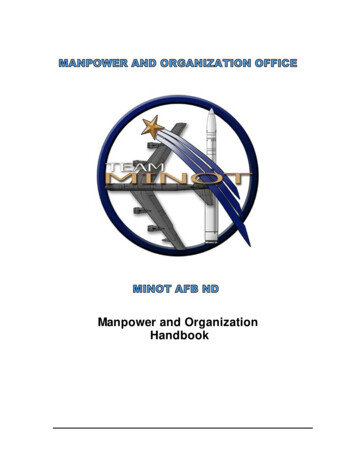
Transcription
Manpower and OrganizationHandbook
TABLE OF CONTENTSOrg ChartUMDPrice-OutsIntroductionVision/MissionCore CompetenciesRequirements Determination Unit Manpower Document (UMD) Air Force Manpower Determinant (AFMD) Wartime SupportOrganization Structure Organization Change Request (OCR) Manpower Change Request (MCR) Total Force Integration (TFI)Performance Management Continuous Process Improvement (CPI) Airmen Powered by Innovation (API)Program Allocation and Control Support AgreementsCommon MisunderstandingsAcronyms
INTRODUCTIONOur office is located at 475 Summit Drive, Room 324Mailing Address:5 FSS/FSM475 Summit Drive Suite 323BMinot AFB ND 58705-5027Phone Number: 723-6267FAX Number: 723-3412E-mail Address: 5MSS.MO@us.af.milSharePoint msg/5fss/FSMM/default.aspxMr. Mark KauerChief, Manpower and OrganizationMr. Gordy MartinCPI/API723-2642Mr. Marc GreenCPI/API723-4215
VISIONThe vision of the 5th Force Support Squadron Manpower and Organization officeis to be a center of expertise helping commanders at all levels make soundresource decisions to maximize the efficiency and effectiveness of missionaccomplishment.MISSIONInitiating and Facilitating Resources and Continuous Improvement for Minot AirForce Base Provides manpower services for 6,382 authorizations worth 498M in two nuclearwings Advises leadership on manpower efficiency, use of requirements and organizationalstructure Leads Air Force Manpower Determinant (AFMD) application and variances studies Overseas wartime employment taskings for 6,313 requirements Conducts Unit Manpower Document to Unit Type Code analysis Markets programs via Commander’s Immersions, Flight Commander’s Course,SNCOPEC, NCOPEC, SharePoint, and “Team Minot” App Assists unit commanders/chiefs in the review of AFMDs Offers CPI Green Belt Facilitator Training on a monthly basis Provide just-in-time Manpower 101 training to Commanders, SNCOs, and NCOPMEManpower Analysts advise Senior Leaders on how to maximizeLethalityReadinessCapabilityRisk Mitigation
Manpower Core Competencies
RequirementsDetermination Requirements Determination Defined as “the manpower needed to accomplish a job, mission, or program.”Can be a funded manpower authorization or an unfunded requirement A manpower authorization is a funded manpower position on the UnitManpower Document (UMD).” Requirements validation should occurevery 2 years per AFI 38-201, Para. 2.8.1., or when Enterprise ProcessImprovement Council (EPIC) determines need and priority. Somecircumstances trigger the need for validating manpower requirements: When directed by HHQo Upon update/publication of a new AFMD (within 90 days)o Upon changes to mission, processes, or workloado When reductions need to be implementedo Standing up a new functiono Upon request to move positionsUnit Manning Document (UMD) The UMD is a detailed tool that consists of the unit’s funded and unfundedauthorizations Executes AF programmed manpower for the current year and projects up to 5 years Shows requirement information only, not personnel assigned to requirement Acts as the baseline for all resource changes made by management. Below areexamples of funded and unfunded UMDs
Funded Unit Manpower Document (UMD) ExampleThe image below is a typical UMD in pdf (also available in Excel format). Followingthat, is an abbreviated list of data codes that could appear on a UMD (there are over100). The green highlighted codes appear on a typical pdf version UMD, but it can becustomized to a specific need.Unfunded Unit Manpower Document (UMD) Example
1. CID: The Command Identification code indicates the Major Command UMDpositions are assigned to.CIDGSMAJCOMAir Force Global Strike Command(AFGSC)2. PAS & UNIT: The Personnel Accounting Symbol (PAS) is a unique four digitalphanumeric code used to identify an organization. The Unit designation identifies thenumber type and kind of the organization. This line will also show a detachmentnumber if applicable.PASF1X6UNIT NAME5 Force Support Squadron3. ILC & ILN: The Installation Location Code (ILC) identifies a particular location. TheInstallation Name (ILN) is the literal title of a recognized place or installation.QJVF Minot AFB4. CSC: A two-character code used to identify the State/Country where manpowerresources are employed.38 North Dakota5. SUB: Defined by each command the subcommand is a logical grouping of aCommand's units.SUBFSUBCOMMAND8th Air Force (8th AF) 5 Bomb Wing6. PAL 2-4: The Personnel Accounting Level (PAL) is a two-digit code assigned to aspecific unit or a group of units permitting their aggregation with the hierarchy desiredby the major command of assignment. MAJCOM establishes and maintains codes.7. MPF: The Military Personnel Office Number designates where the servicing MilitaryPersonnel Section (MPS) is located.MPFMPSERVICING MILITARY PERSONNEL SECTIONMinot8. CPO: The Civilian Personnel Office Number (CPO) designates the location of theservicing CPO.CPO8OSERVICING CIVILIAN PERSONNEL OFFICEMinot
9. MOF: The Servicing Manpower Office (MOF) The manpower office that services theunit, usually same as the MPF code for the installation where the Manpower Office islocated. The Wing level MOF may, or may not service tenant units belonging to anotherMAJCOM.MOFMPSERVICING MANPOWER & ORGANIZATION OFFICEMinot10. PPN & PARENT UNIT: The Parent PAS Number (PPN) code identifies thePersonnel Accounting Symbol (PAS) for the command level immediately above thecurrent unit or PAS. The Parent Unit indicates the next higher Unit in the Air ForceOrganizational Structure.11. OSC & OSC TITLE: The Office Symbol Code (OSC) is a 2 to 7 character code thatidentifies the work center or office where the position is authorized and identifies theinternal organization of a unit.12. FAC & FAC TITLE: The Functional Account Code (FAC) is a six-digit code used toidentify a homogenous grouping of tasks. That is, we group together personnel usingsimilar machines and methods of operations. They are usually located in a centralizedarea. Personnel perform work that contributes to the same end product and their dutiesare similar or closely related.The first four digits are controlled by HQ USAF and describe the organization down tothe basic function. The last two digits are MAJCOM-controlled and are used to identifycommand unique work centers.-Functional groups are divided into seven categories to identify the major typeof work mmand and Command SupportMission Equipment MaintenanceMission Equipment OperationsDirect SupportMedicalResearch and Development
-The first and second digits of a FAC, when combined, represent the basicfunction of the major grouping (11XX - Info Mgt, 15XX - Comptroller, etc.).The third and fourth digits of a FAC provide a more detailed description ofthe basic function. Examples shown 0542100FAC TitleJudge AdvocateOps/PlansFinancial MgtFlight CrewsVehicle OpsSecurity PoliceYouth ActivitiesClinical Dentistry13. POS NBR: The Position Number is a ten-digit alpha-numeric number used toidentify each position. The last two digits indicate the Major Command. The positionnumber provides an interface between the manpower and personnel data systems andallows us to track changes to the position detail over time.14. PPS: The Projected Position Sequence (PPS) identifies projected changesprogrammed against a specific position number. “0” indicates the original position and“1” indicates the first projected change for the position.15. ASP, AFSC & TITLE: The Authorized Specialty Prefix (ASP) is a single character,alpha code used with the AFSC on a position on the UMD and personnel serving in orqualified to serve that have or require special training or experience. The ASP will beaffixed to the Duty AFSC (entry, intermediate, qualified, or staff, if an officer) uponassignment to these positions and retained only so long as they are incumbents. TheASP may be combined with the AFSC as a single data element, on your UMD.The Air Force Specialty Code (AFSC), as listed in AFOCD (for Officers), AFECD (forEnlisted), is used to represent a specific military occupational specialty, skill, orqualification.ASPXXXAFSCXXXXXXXXXXXXXXXAFSC TITLEOfficer AFSC Title ? Prefix – Prefix DefinitionEnlisted AFSC TitleEnlisted AFSC Title ? Prefix – Prefix DefinitionSkill levels 4 th char. of AFSC (X): 3 – Apprentice5 – Journeyman7 – Craftsman9 – Superintendent
16. SEI: The Special Experience Identifier identifies any special skills or advancedtraining associated to the workload requirement. SEI codes are optional on civilianauthorizations. A few examples shown below.SEIDESCRIPTION356435HAZARDOUS MATERIALS TRAINERARMY COMBAT SKILLS TRAINING17. RIC: The Resource Identification Code (RIC) identifies the resource category withina manpower appropriation. Each RIC has only one appropriation. The RIC is a fourposition code which also identifies the type of resources assigned to each programelement. If your unit has unique manpower authorizations such as IMA billets, you maywant to call us to ensure you receive the appropriate STEDCIVILIAN (DOD)CME (CONTRACT MANPOWER EQUIVELENT)18. GRD: The Authorized Grade (GRD) is the grade that the personnel system uses toassign personnel. It is the “funded” grade, which may be different than the “required”grade. CME is the number of in-service man-years that would be required if thecontracted workload was performed in-house at the same workload and performancelevel required in the contract performance work statement.19. RGR: The Required Grade (RGR) for the position as earned by the applicable AirForce Manpower Standard or Capabilities based Manpower Standard (AFMS or CMS).Differences between the required grade and the authorized grade are caused byfunding constraints, Career Progression Group (CPG) allocations, or implementation ofa revised manpower standard.20. MNT: The Manpower Type (MNT) is divided into separate categories: MNT1indicates the funding status of a position in the FYDP, MNT2-the utilization of theposition, MNT3-the work status, MNT4-appropriations, MNT5-category; certain types ofno-FYDP manpower positions.MNTRXXXXXXXXXDESCRIPTIONUNFUNDED FULL TIME INSERVICE APPROPRIATEDFUNDED FULL TIME INSERVICE APPROPRIATEDNote: Peacetime positions are not funded; Authorizations are funded at the GRD.21. API: The Aircrew Position Identifier (API) is a code used to identify a position thatshould be filled by an officer or enlisted with a specific operational flying rating. Thiscode, previously known as Flying Position Identifier (FPI) or Rated Position Identifier(RPI), is used to identify officer (numeric) and enlisted (alpha) positions according to
their rating requirement. A “0” in this column depicts officer authorizations that do notrequire rated eer enl aviator--cea--line flyerscea staff/supv wing/below must flycea staff/supv wing/below not flycea staff/supv above wg must flycea staff/supv above wg not flycea – ot&e/fms/-- must flyCea flying duties non usaf unitsNo title – umd4 migrationnon-career enl aviator positions0123456789non-rated officer positionspilot--line flyersnavigator--line flyersrated staff/supv wing/below not flyrated staff/supv above wg not flyflight surgeonrated staff/supv wing/below must flyrated flyers—non usaf unitrated staff/supv above wg must flyAir Battle Manager22. AEL: The Academic Education Level (AEL) code represents the area of educationalendeavor in which an individual is uniquely qualified to perform. This field is normallynot visible on a standard UMD.AELDESCRIPTIONHJPRENLISTED ASSOCIATE'S DEGREECIVILIAN ASSOCIATE'S DEGREEMASTERS DEGREEDOCTORATE DEGREE23. PEC: The Program Element Code (PEC) represents a subdivision of programmedcost data (people, equipment, and facilities) related to a weapon system or supportfunction. Some examples shown below.PECDESCRIPTION11969A11969N11113A11113MCBT SPT BASE OPERATIONS SUPPORTCOMBAT BASE OPERATIONS SUPPORT (NUCLEAR)B-52 SQUADRONSB-52 ACFT/MUN24. DTY: The authorized Duty Title code is a three-digit code indicating the identifyingtitle for a specific UMD position. The Duty Title will override the Air Force Specialty Title(AFS) on the UMD. Some examples are listed below. This is not the same thing as theDuty Title in MILPDS.DTY DERFLIGHT CHIEFSUPERINTENDENTSUPERVISORFLIGHT COMMANDER
25. CEC: The Civilian Employment Category (CEC) shows the category in which thecivilian would be hired.CECDESCRIPTION102080GENERAL SCHEDULEWAGEBOARDCONTRACT MANPOWER EQUIVALENT26. OCC: The Occupational Series code identifies a specific qualification required of thecivilian employee occupying the related authorization. This field is normally not visibleon a standard UMD. A small sampling of these is shown 0318TO BE DETERMINEDSAFETY & OCCUPATNL HEALTH MGMTSECURITY ADMINFIRE PROTECTION AND PREVENTIONPOLICEHISTORYSECRETARY27. SAR: The Security Access Requirement code identifies the day-to-day level ofaccess to classified information required by the position. *Requests to change SARcodes must be coordinated through 2 BW/IP, and, if increase to SSBI or higher, therequest must also be approved by AFGSC/CC before sending to the Manpower office.Please review the SAR related guidance at the end of this document prior to requestinga SAR code level increase.SAR56789DESCRIPTIONSSBI (SIN SCP BK IN) Top SecretNACLC (NT, LOC, CRED) Secret MilitaryANACI ACC NT AGV IN Secret CivilianNACI (NAT AGY CK IN) No Access CivilianNAC (NAT’L AGY CHK) No Access
28. PRP: The Personnel Reliability Program status code identifies position requirementsthat require a PRP certified or Non PRP certified but with Nuclear Experience qualified,individual. For example: “A” Certified PRP Critical –Prior nuclear experience notrequired. “N” Certified PRP Critical –Must have prior nuclear experience. Thesecodes apply to the position and should not be confused with PRP codes attached topersonnel. The UMD requirement is what the Personnel System will attempt to fill withthe appropriate member.PRPDESCRIPTIONADNIZAUTH-ASGN: CRIT FOR NUC WEAPON DUTY (NO PREV EXP)AUTH-ASGN: CONTROLLED NUC WEA DY (NO PREV EXP)AUTH/ASIGN:CRIT NUC WPN DTY(NUC EXP RQ)AUTH/ASIGN:CONT NUC WPN DTY (NUC EXP RQ)AUTH/ASIGN:NUC EXP REQ (NO PRP)29. XFA: Identifies positions designated as “Key Nuclear Billets” (KNB), “NuclearCommand, Control and Communication” (NC3), and the emerging requirement for“Nuclear Enterprise Civilian” (NEC). The “KNB” codes were previously found in the “AFRMK 2” data field, they now have this discrete field for the various codes. The firstcharacter is reserved as “N” and indicates Nuclear Enterprise. The second and thirdcharacters further define the attributes of the position with specific emphasis given tohighlight whether the position is a KNB, NC3, NC or combination thereof.a. K – Key Nuclear Billet (KNB), as defined by AFI 13-504, Key NuclearBillet (KNB) Program.b. 3 – Nuclear Command, Control and Communication Billet (NC3)c. C – Nuclear Enterprise Civilian Billet (NEC)d. D – Billet designated as both KNB and NC3e. E – Billet designated as both NC3 and NECf. F – Billet designated as both KNB and NECg. G – Billet designated as KNB, NC3, and NEC410 MGM 15-8 Guidance for UMD CoFor example, a billet designated as both KNB and NEC will be coded as “NF” in the XF1data field. A billet that is solely identified as NEC will be coded “NC” on the UMD.XFANC3CNSNGNKN3NCNDNENFXFA TitleNUCLEAR COMMAND, CONTROL AND COMMUNCATIONCYBERSPA CENUCLEARSPACEKEY NUCLEAR BILLET-: NUCLEAR COMMAND, CONTROL, COMMUNICATION -NUCLEA RENTERPRISE CIVILIANKEY NUCLEAR BILLETNUCLEAR COMMAND, CONTROL, COMMUNICATIONNUCLEAR ENTERPRISE CIVILIANKEY NUCLEAR BILLET-: NUCLEAR COMMAND, CONTROL, COMMUNICATIONNUCLEAR COMMAND, CONTROL, COMMUNICATION -NUCLEAR ENTERPRISE CIVILIANKEY NUCLEAR BILLET - NUCLEAR ENTERPRISE CIVILIAN
30. MSI: Manpower Standard Implementation: Identifies the Manpower determinantused to quantify the manpower for a work center. Each manpower position will becoded with the determinant used to validate the requirement.31. CMD RMK: The Command Remarks code identifies MAJCOM uniquecharacteristics of a requirement not adequately defined by other data codes.CMD SIOXXX05PB 902 MIL/CIV CONVPERSONNEL SERVICE DELIVERYCIV AUTH LOST IN RIF FY04NUMBERED AF SUPPORTPBD722 MCCN 26CEB722SINGLE OPLAN TOFF AFSIOP GENERATION SUPPORT32. AF RMK: The Air Force Remarks code identifies authorizations utilized in theaccomplishment of a mission but are not adequately defined by other data codes.AF RMKDESCRIPTIONF4PAPFSAEXCEPTION TO STDPBD 722 CIVILIAN SIDE OF CONVERSIONPBD 712 MIL CIV CONVERSIONSTRESS ADD33. LRK: The Local Remark Code identifies installation unique characteristics of anauthorization not adequately defined by other data A/BOS2A5STRAIGHTLINE D W/ 04 LCOMEARNED IN MXMTC LCOM 04SSGT 2A551K POS EARNED IN MAFSEARNED IN 2MXS/MXMTCEARNED UNDER 04 LCOM/MXWCPTEARNED IN MXABW LCOM02SRA 2A553B POS EARNED IN MAOS
34. RSC: The Commercial Activity Reason code is a one-digit alpha code thatdescribes why an activity is performed in-house. This field is normally not visible on astandard UMD.RSCDESCRIPTIONATHE COMMERCIAL ACTIVITY IS NOT APPROPRIATE FOR PRIVATE SECTORPERFORMANCE PURSUANT TO A WRITTEN DETERMINATION BY THE CSO.THE COMMERCIAL ACTIVITY IS SUITABLE FOR A STREAMLINED OR STANDARDCOMPETITION.THE COMMERCIAL ACTIVITY IS THE SUBJECT OF AN IN-PROGRESS STREAMLINEDOR STANDARD COMPETITION.THE COMMERCIAL ACTIVITY IS PERFORMED BY GOVERNMENT PERSONNEL AS THERESULT OF A STANDARD OR STREAMLINED COMPETITION (OR A COSTCOMPARISON, STREAMLINED COST COMPARISON, OR DIRECT CONVERSION)WITHIN THE PAST FIVE YEARS.THE COMMERCIAL ACTIVITY IS PENDING AN AGENCY APPROVED RESTRUCTURINGDECISION (E.G., CLOSURE, REALIGNMENT).THE COMMERCIAL ACTIVITY IS PERFORMED BY GOVERNMENT PERSONNEL DUE TOA STATUTORY PROHIBITION AGAINST PRIVATE SECTOR PERFORMANCE.BCDEF35. YLR: The Year of Last Review is a four-digit numeric code representing the fiscalyear when a review was last completed on the activity to determine it appropriate modeof operation (in-house or contract). This field is normally not visible on a standard UMD.36. YNR: The Year of Next Review is a four-digit numeric code representing the fiscalyear when the next scheduled review will be completed on the activity to determine itappropriate mode of operation (in-house or contract). The YNR should not exceed fiveyears from the YLR. This field is normally not visible on a standard UMD.37. FCT: The Functional Category represents the general funding category of arequirement. This field is normally not visible on a standard UMD.FCT1XXX2XXXDESCRIPTIONCommand and Command SupportMission Equipment Maintenance3XXX4XXX5XXX6XXXMission Equipment OperationsDirect SupportMedicalResearch and Development
38. EFF and TRU: The Authorization Effective Date and Authorization Through Dateindicates when and for how long they will remain in effect.EEF is the date authorization becomes effective.TRU is the date an authorization is effective through. Normally the date will bethe first day of a Fiscal Quarter. Authorizations effective indefinitely will have 31 DEC4712 as the through date.Air Force Manpower Determinant (AFMD) Manpower Standard Development AFMD is a tool used to quantify manpower resource requirements by anticipatingthe frequency or workload count of products issued and services provided Developed by the Manpower Requirements Squadron (MRS) utilizing subjectmatter experts (SMEs) to obtain workload data When AFMD is approved by Headquarters Air Force, these standards will beapplied to all applicable Air Force activities Requirements will be shown on your UMD as either a funded or unfundedrequirement A funded requirement is able to be sourced immediately upon applicationof standard because sourcing/funding is available A unfunded requirement is still a valid requirement but due to fundingcannot be sourced upon application of AFMDStandard Application or Reapplication Base level manpower offices will apply AFMD developed by the MRSs to units attheir local installation If HQ requests an application be accomplished on a function, Minot AFBManpower Team will be ready to assist in efforts Applications are not limited to MAJCOM or JQ Air Force request only, they will beapplied periodically in order to provide base-level leadership a solid baseline for anyresource management decisions Variance Development A variance is a deviation to an AFMD that is developed when additional workloadrequirements are not covered by the core standard Variances are not required to cover every single man-hour within a function andshould only be used when a significant difference in workload requirements is notaddressed otherwise Must meet a minimum of 25 monthly man-hours, should not be limited by location
Wartime Manpower Support Assist commanders and FAMs in comparing and matching manpower resourcesto requirements, documenting results, and recommending solutions to commandersand FAMs. Assist FAMs in determining the need for new UTCs and validate the manpowerrequirements of existing UTCs Provides UTC/UMD comparison to the Installation Deployment Officer (IDO),commanders, designated representatives, wing leadership and the MPF asrequested Verify information of tasked requirement utilizing DCAPES Compare and match resources to requirements within acceptable constraints andidentify potential mismatches, overages and/or shortages. Assist commanders andFAMs in satisfying shortfall requirements from within existing wing/center resources. Provide unit SORTS/ART monitors with deployment and in-place requirementsdata, and advise commanders of options to resolve discrepancies between the totalUTC/in-place requirement needs and available UMD authorizations. Assist commanders and the Base Augmentation Review Board (ARB) withdetermining and validating ARB requirements to support the scenario of theaugmentation program (e.g., sustained contingency requirements for basesurvivability, security forces, command post and cargo-marshaling.) DocumentExemptions and calculate the Fair Share with remaining available support IAWAFPAM 10-243, Augmentation Duty. Build local exercises, worst case scenarios and base support plans in support oflocal commanders and the IDO.
OrganizationStructure Air Force organizational structure follows these management principles: Emphasis on Wartime Tasks. Organizations are structured to accomplish wartime tasks withoutreorganizing Functional Groupingo Organizations have these characteristics: A clear-cut purpose, goal and scope, with one individual in charge Parts that form a logical, separable activity A close relationship among the parts, constituting a complete entity Natural divisions of work that clearly define where responsibilitybegins and ends Lean Organizational Structures Organizations should encourage rapid decision making, so they should be flatstructures without intermediate levels, unless mission requirements cannototherwise be met. When used, intermediate organizations should consist oftactical functions only, without a full range of staff functions. Organizational levels that exist only to review and transmit information ortasking should be eliminated Both the number of supervisors and the number of internal subdivisions withinorganizations should be designed to minimize layers and maximize worker-tosupervisor ratios. Skip-Echelon Structure Major commands (MAJCOM) sit on top of a skip-echelon staffing structure MAJCOMs, wings and squadrons possess the full range of staff functionsneeded to perform required tasks
Numbered/named air forces (NAF), groups and flights have no or minimalstaffo These tactical echelons are designed to increase operationaleffectiveness rather than to review and transmit paperworko The chain of command and responsibility for mission accomplishmentruns through commanders at all levelsStandard Levelso The Air Force uses the standard levels described in AFI 38-101, Chapter 2to design organizations Establish organizations at the lowest level required to successfullyaccomplish the primary missionStandard Wing Structure Example
ORGANIZATIONAL CHANGE REQUESTS (OCR) Organizational structure must use the standard organizational structures found inAFI 38-101, if a unit’s unique mission or location requires a different structure, awaiver to the standard structure can be requested using the organizational changeprocedures An OCR is the unit’s official request to make a change to an approved structure OCRs are submitted because of:o Changes in AFMDo Changes in programmingo Changes in missiono A decision by the SECAF or CSAFo A decision by congress When submitting an OCR the following 8 questions must be answered:1. What is the proposed action? (list specific actions, such as activation,inactivation, nomenclature change, reorganization, or variation request)?2. Why is the action needed? What are the expected benefits? (Identify factorsdriving the need for the action, e.g., changes to Instructions, missions orconcepts of operations; attach any substantiating Air Force directives. Indescribing expected benefits, identify improvements, examples of increasedmission capability and so on.3. What is the structure of the new organization? (include current and proposedorganization and function charts showing authorized and proposed manpower byofficer, enlisted and civilian.)4. Explain how the proposed structure compares with standard structure,nomenclature and size guidance and provide rationale for any requesteddeviations.5. As a result of this request, are any changes needed to add or deleteOrganization Nomenclature Codes or Office Symbol Codes (OSCs) or to changethe title for an OSC; if so, provide the following information. (strive to use existingcodes rather than creating new ones)6. For unit activations or re-designations, explain why the proposed unit designationwas chosen. Identify any inactive historical units you’re proposing to use andexplain why you want to use these units.7. What is the cost of the request in terms of dollars and resources? (document costin terms of dollars and manpower. Include administrative costs such as flags andsigns, as well as manpower increases or monetary costs directly driven by therequested reorganization action.)8. Provide a mission directive, statement or description for organizations beingactivated or reorganized. A submission guidebook is available upon request to assist you in preparing theformal OCR package.
MANPOWER CHANGE REQUESTS (MCRs)The format outlined on the following pages should be used when submitting an MCR.AFGSC has given us specific direction concerning change requests and we ask thatyou provide all the necessary information in your MCR. This will prevent additionaldelays in processing. Please use the imbedded MCR template below to prepare yourchange request. Some areas of particular concern are listed below.a. Submission of “realignments” must consider the status of manpower in bothfunctions. It is usually inappropriate to realign from a function with unfundedauthorizations when there are other functions funded at 100 percent of earnedmanpower. Identification of a trade-off simply because a function is large may not beappropriate. Mission priority must also be considered. Maintenance spaces should notbe identified to fund a lower mission priority support function.b. A Program Element Code (PEC) is a subdivision of programmed cost datarelated to a weapon system or support function. Increases or decreases between PECcodes are very difficult to justify. Air Staff and HQ AFGSC control the PECs. If anincrease in manpower is requested, you must list positions within the same PEC codefor use as a trade-off.c. Changes that deviate or conflict with existing Air Force manpower standards maynot be processed unless changes are absolutely necessary for missionaccomplishment. Example: you should not attempt to move positions from a FACwhere they are “earned” to a FAC where they are not. This practice is highlydiscouraged because it makes the positions vulnerable to loss as they appear to beexcess. Only emergency changes can be made to functions that are under study forstandards development. Changes will not be made to functions where manpowerstandards implementation is pending.d. Changes in military authorizations must be UTC validated and the MCR willcontain the statement that these changes will not cause a UTC/UMD mismatch. YourUDM should perform a UTC/UMD comparison prior to processing any MCR involvingmilitary authorizations. This will prevent your unit from being unable to meet yourtasking requirements due to insufficient UMD positions.e. Changes in civilian authorizations must be reviewed and approved by the CivilianPersonnel Office, 2 FSS/FSMC, prior to being submitted to the Manpower office.Include a statement that identifies if the authorization is vacant; if the position is notvacant, we may not be able to process the changes due to an adverse impact againstthe civilian. The CPO will endorse the MCR stating, “No adverse civilian action will becaused by the requested change.”f. *Changes to SAR codes must be coordinated through 2 BW/IP prior tosubmission to the Manpower office. There are additional requirements if you wish toincrease a SAR code to anything above “SECRET”. Refer here for SAR code guidance
g. PRP code changes are done at the unit commander’s discretion unless there isregulatory guidance dictating a certain code. All PRP code changes must b
Organizational Structure. 11. OSC & OSC TITLE : The Office Symbol Code (OSC) is a 2 to 7 character code that identifies the work center or office where the position is authorized and identifies the internal organization of a unit. 12. FAC & FAC TITLE : The Functional Account Code (FAC) is a six -digit code used to

